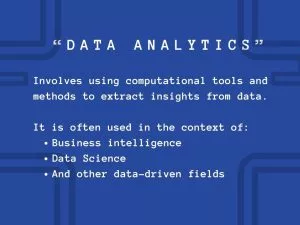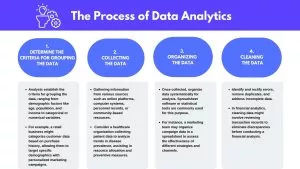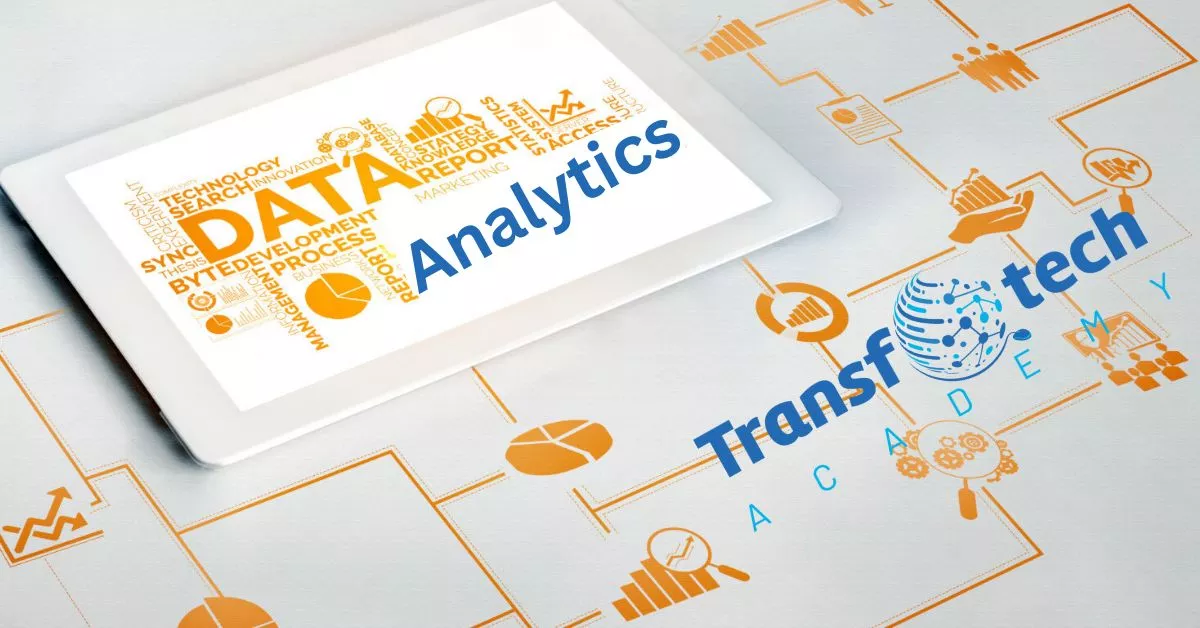“Hey, you might really like these videos based on what you’ve enjoyed before!” How does it know that?
You must be familiar with YouTube, the world’s biggest online video-watching application, with over 2 billion active monthly users. And you might have noticed that the app shows you personalized content suggestions.
You see, data is like a superpower for organizations. So, if you’re good at analyzing things and enjoy solving problems, a job in data analytics could be your next big career step.
So, what is data analytics actually? Let’s learn further, including what skills one needs to be a data analyst.
Get a Deep Look: What Is Data Analytics?
Data analytics is like detective work in the world of data science. It’s all about looking closely at raw data to find patterns and trends. When data analysts do this, they can figure out important information. These insights are like clues that help make important decisions. The main aim of data analytics is to solve specific problems or challenges that a business might have, making everything run smoother.

In today’s world, being smart about decisions is super important. Whether a company wants to understand its customers better, improve how things work, or discover new opportunities, using data analytics is the key to success.
It’s important to note that data analytics is a discipline that has a broad scope across the fields.
However, it’s not a one-size-fits-all process. Because the scope of data analytics varies across different fields. Hence, different industries use different methods to solve different problems. Therefore, it’s difficult to say which industry uses data analytics the most compared to others.
| Overall, a successful data analytics project brings together all the important pieces to answer questions about the past, predict the future, and help make decisions that really work. |
What Are the Types of Data Analysis?
There are four main types of data analytics: descriptive, diagnostic, predictive, and prescriptive. Each type of analytics has its unique purpose and can be used to answer different questions.
Photo Credit: Bing, DALL-E
In the table below, we will explore each type of analytics in detail and provide examples of how they can be used to improve decision-making.
Type of Data Analytics |
Purpose |
Examples |
| Descriptive analytics | Helps answer the question, “What happened?” | Describing outcomes to stakeholders, tracking successes or failures, developing KPIs, and tracking performance specific to an industry. |
| Diagnostic analytics | Helps answer the question, “Why did this happen?” | Identifying anomalies in the data, collecting data related to these anomalies, and implementing statistical techniques to find relationships and trends that explain the anomalies |
| Predictive analytics | Helps answer the question, “What will happen in the future?” | Using historical data to identify trends and determine if they are likely to reoccur or change. |
| Prescriptive analytics | Helps answer the question, “What should be done?” | Using insights from predictive analytics to make data-driven decisions, even in the face of uncertainty. |
The Journey of Data Analytics Involves Several Stages.
Check the Next Section to Learn More.
4 Stages of Data Analytics Process
Each stage of data analytics plays a vital role in extracting valuable information. In this context, we’ll explore four key stages of data analytics with real-life examples.

Fun Facts:
This explosive growth offers an excellent chance to improve your data analytics abilities, for example, by enrolling in a course. |
Learn About Skills Required to Become a Data Analyst
There’s a big push for something called “digital transformation,” creating a high demand for hiring data analysts across industries. Whether you’re into telecommunications, manufacturing, retail, banking, healthcare, or even fitness, there are job opportunities for data analysts everywhere.
Note that getting into data analytics takes some serious learning and effort. You need to be good with tech stuff, like using specific computer programs. Besides that, you also need “soft skills,” things like thinking critically and communicating well. People learn these skills in different ways – some go to advanced degree programs, while others prefer shorter and more affordable professional courses. No matter how you do it, you’ve got to build up a strong set of skills to be a successful data analyst.
So, here are the skills you need to focus on:
1. Technical Skills
SQL: Structured Query Language, or SQL, is a spreadsheet and computing tool capable of handling large sets of data. It can process information much more quickly than more common spreadsheet software.
Spreadsheets: While SQL is often the preferred software for data analysts, knowledge and understanding of traditional, widespread spreadsheet tools is necessary. Some companies may want their reports or data sets to be presented through traditional spreadsheet tools. Data analysts may use programs like:
- Microsoft Excel
- Quip
- Zoho Sheet
- WPS Spreadsheets
Statistical Programming Languages: Some data analysts choose to use statistical programming languages to analyze large data sets. These are some languages you can use as a data analyst:
- R
- Python
- SAS
- MATLAB
- Stata
- SPSS
2. Analytical Skills
Data analysts must be able to analyze data, identify patterns and trends, and draw conclusions based on their findings. They must be able to think critically and creatively to solve problems and make decisions.
3. Mathematical Skills
You should have a strong foundation in mathematics, including statistics, algebra, and calculus. You must be able to use mathematical models to analyze data and make predictions.
4. Communication Skills
You must learn to communicate your findings to others clearly and concisely. This way, you can explain complex data analysis concepts to non-technical stakeholders.
5. Business Acumen
You have to understand the business you are working for and the industry it operates in. Therefore, you identify opportunities for growth and improvement and make recommendations based on their findings.
Final Remarks: Start Your Career in Data Analytics
Entering data analytics is like gaining a superpower in today’s job market. With global data exploding, skilled analysts are in high demand. If you enjoy problem-solving and analyzing information, a career in data analytics could be your next big move.
To embark on this journey, you need a mix of technical and soft skills, including proficiency in tools like SQL, spreadsheets, and programming languages like R and Python. Analytical, mathematical, and communication skills, along with a business understanding, complete the skill set.
If you’re intrigued by uncovering data patterns and making impactful decisions, start your data analytics journey—the world of opportunities awaits!
Get More Information: FAQs
What Is a Data Analytics Software?
Data analytics software is a tool that aids businesses in analyzing data for improved decision-making. Examples include Tableau, Microsoft Power BI, and Google Analytics. These tools help identify patterns and trends that may be challenging to discern otherwise.
What Are the Common Challenges in Data Analytics?
Common challenges in data analytics include data quality issues leading to inaccurate results, difficulties in data integration from various sources, a shortage of skilled analysts, and concerns about data security and unauthorized access.
How Has Big Data Impacted Data Analytics?
Big data has significantly influenced data analytics by providing access to vast amounts of data. This has led to the development of tools for analyzing large datasets, enabling the identification of patterns and trends that would be challenging with smaller datasets.
What Is the Importance of Data Analysis?
Data analysis is crucial for helping businesses make informed decisions. By identifying patterns and trends, companies can enhance operations, make better decisions, and uncover opportunities for growth and innovation.
What Is the Difference between Data Analysis and Data Analytics?
While often used interchangeably, data analysis is the examination of data to identify patterns and trends. Data analytics is a broader term encompassing the entire process, including collecting, processing, and analyzing data. It includes tasks like data cleaning, modeling, and visualization, going beyond the scope of data analysis.

115 Responses
canada viagra buy
The amount of effort that you put into it was very impressive to observe. Despite the fact that the picture is appealing and your writing style is elegant, it appears that you are concerned about the fact that you ought to be providing the following content. In the event that you take care of this hike, I will almost definitely return to come back and read more of your work.
Dear [family member], I would like to express my admiration for this exceptionally well-written post that contains nearly all pertinent information. I am inclined to discover more posts of the same caliber.
Outstanding feature
This was beautiful Admin. Thank you for your reflections.
furosemide vs thiazide
lisinopril 20mg tab
zoloft fatigue
is flagyl a strong antibiotic?
lasix vs spironolactone
gabapentin migraine
glucophage lawsuits
zithromax and drinking alcohol
is cephalexin
how much is gabapentin
can u drink on amoxicillin
•escitalopram
ciprofloxacin dosing
how long does it take cephalexin to work
how long after taking bactrim can i breastfeed
can you drink while taking bactrim
cephalexin killed my dog
amoxicillin 500mg side effects
side effects of gabapentin
Thanks for sharing. I read many of your blog posts, cool, your blog is very good.
lorazepam vs escitalopram
I just like the helpful information you provide in your articles
citalopram 40mg
depakote and pregnancy
cozaar harley davidson
plavix and ddavp
what is citalopram used for
depakote taper schedule
cozaar losartan potassium
vasopressin adh ddavp
I’ve been browsing online more than 2 hours today, yet I
never found any interesting article like yours. It is pretty
worth enough for me. In my opinion, if all website owners and bloggers
made good content as you did, the web will be a lot more useful than ever before.
I really love your site.. Excellent colors & theme.
Did you develop this site yourself? Please reply back
as I’m wanting to create my own website and would love to
find out where you got this from or exactly what the theme is called.
Appreciate it!
voltaren diclofenac
ezetimibe aha
augmentin xr dose
diltiazem 2 cream
what is the generic for flexeril
effexor weight gain reddit
flomax ofis
rybelsus vs contrave
allopurinol 300 mg cost
cost for aripiprazole 30mg
amitriptyline goodrx
molecular weight of aspirin
how fast does celebrex work
baclofen rob holland
bupropion naltrexone
augmentin vs amoxicillin
Your article helped me a lot, is there any more related content? Thanks!
СПОНТАНЕЙНОЕ В ПСИХОЛОГИИ
СПОНТАНЕЙНОЕ В ПСИХОЛОГИИ https://batmanapollo.ru/%d1%81%d0%bf%d0%be%d0%bd%d1%82%d0%b0%d0%bd%d0%b5%d0%b9%d0%bd%d0%be%d0%b5-%d0%b2-%d0%bf%d1%81%d0%b8%d1%85%d0%be%d0%bb%d0%be%d0%b3%d0%b8%d0%b8/ СПОНТАНЕЙНОЕ В ПСИХОЛОГИИ
СПОНТАНЕЙНОЕ В ПСИХОЛОГИИ
celecoxib warnings
ashwagandha amazon
para que sirve buspirone hcl
Causa finita est — Дело кончено, вопрос решён.
celexa and weightloss
I don’t think the title of your article matches the content lol. Just kidding, mainly because I had some doubts after reading the article.
ozempic semaglutide
abilify for bipolar 2
acarbose 25
Insightful piece
remeron and seroquel
robaxin for horses
repaglinide mylan generics
protonix for gerd
Your point of view caught my eye and was very interesting. Thanks. I have a question for you.
happy family rx
synthroid spotting
information about spironolactone
para q sirve la sitagliptina
synthroid interacciones
Thank you for your sharing. I am worried that I lack creative ideas. It is your article that makes me full of hope. Thank you. But, I have a question, can you help me?
what does tamsulosin hydrochloride do
venlafaxine side effects
prednisone 10mg price in india
voltaren gel dosage card
tizanidine 4 milligrams
canadian neighbor pharmacy
buy discount cialis best online
zyprexa vs seroquel
wellbutrin stopping use
prednisone online pharmacy
what are the side effects of zetia
zofran meclizine
how zyprexa works
alternative to zofran